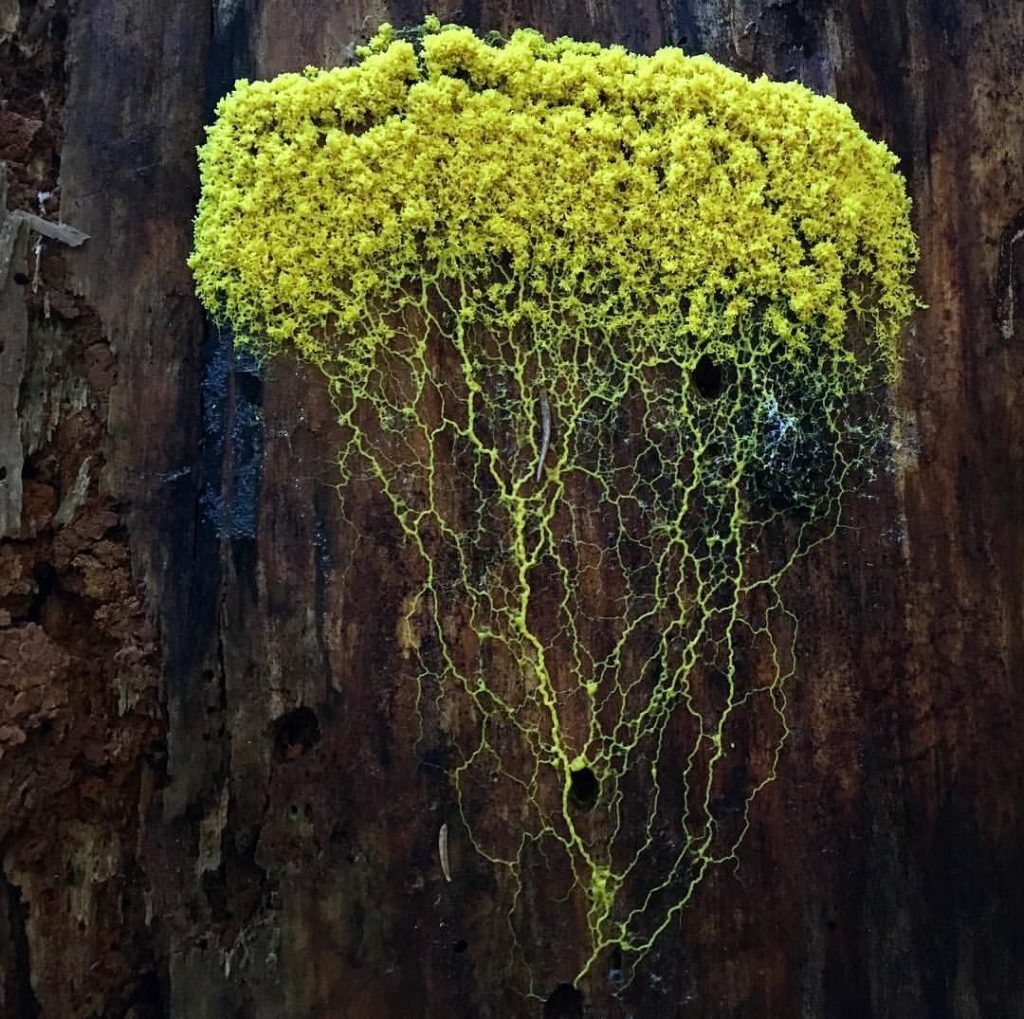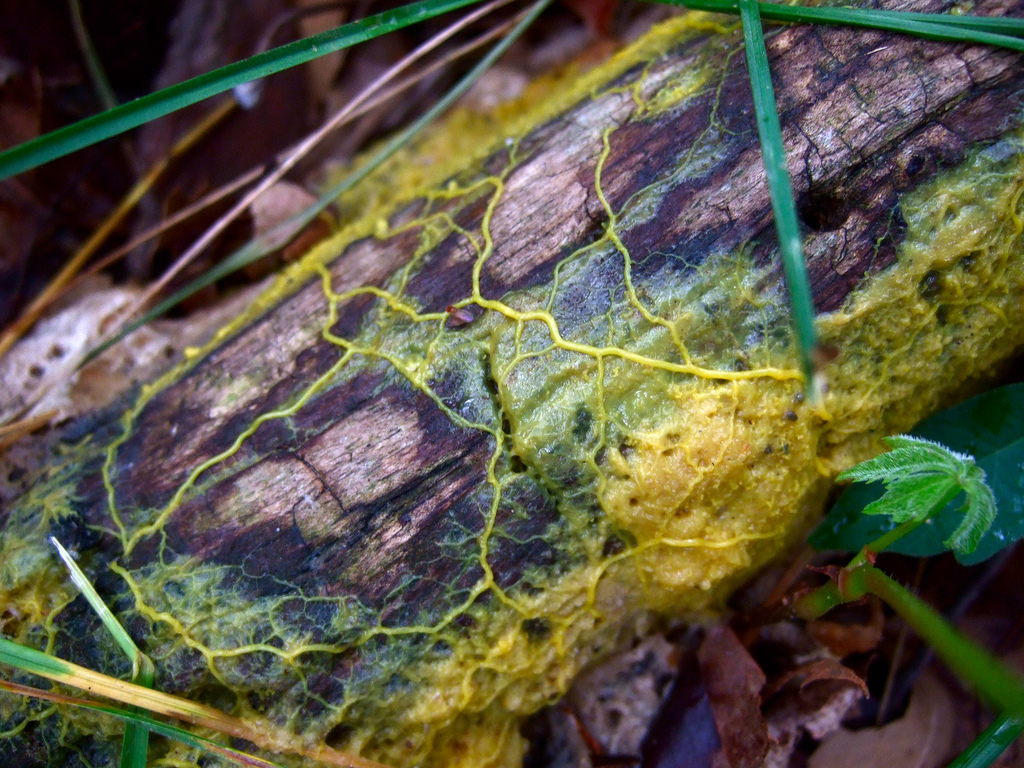
Physarum polycephalum is een slijmzwam, een niet cellulaireprotist, een organisme dat noch dier, plant of schimmel is. Physarum komt voornamelijk voor in vochtige schaduwrijke plekken, en dan voornamelijk op en nabij boomstammen. Het organisme werd door zijn gelijkenis met schimmels misgecategoriseerd en onder de fungi geschaard. Physarum wordt binnen de wetenschap veel gebruikt voor onderzoek naar motiliteit, celdifferentiatie, chemotaxis, celcompatibiliteit, en het verloop van de celcyclus. https://nl.wikipedia.org/wiki/Physarum_polycephalum
—–
Physarum polycephalum (griechisch πολύς polys ‚viel, mehrere‘, κεφαλή kephalē ‚Kopf‘) ist eine Schleimpilz-Art aus der Ordnung der Physarida und lässt sich somit den Myxogastria (auch Myxomyceten oder Echte Schleimpilze) zuordnen. Das vielkernige, von einer einzigen Zelle gebildete Phaneroplasmodium ist aufgrund seiner Größe (bis zu mehreren Quadratmeter ) mit bloßem Auge erkennbar. Diese Art ist gut beschrieben, da sie als Modellorganismus häufig in Laboren zu Studienzwecken eingesetzt wird.
In Anspielung an die außerirdische, menschenverschlingende Substanz aus dem Science-Fiction-Film Blob – Schrecken ohne Namen wird sie scherzhaft auch „der Blob“ genannt. Der Schleimpilz wurde von der Deutschen Gesellschaft für Protozoologie zum „Einzeller des Jahres“ 2021 gekürt.
Merkmale
Die gelben bis grauen (selten weißen), unregelmäßig linsen- bis scheibenförmigen oder aufgerollt bis gewunden-zusammenfließenden Sporokarpe sind 1 bis 1,5 Millimeter breit, 1,5 bis 2 Millimeter hoch, gestielt und stehen gehäuft zusammen. Die Hülle des Sporokarps, die Peridie, ist häutig, brüchig, weiß oder blassgelb und mit gelben bis weißen Kalkknötchen besetzt. Der gelbe, durchscheinende Stiel ist lang, schlank, biegsam und ineinander verdreht, gelegentlich am Ansatz abgeflacht und verbreitert. Das feine, dichte Capillitium ist physaroid, bildet also ein Netzwerk, in dem verdickte, unregelmäßig geformte, gelbe bis weiße, kalkhaltige Knoten durch schlanke, durchscheinende und kalkfreie Fäden miteinander verbunden sind.
Die im Durchmesser 8 bis 11 Mikrometer messenden, aufgerauten bis feinstachligen Sporen sind in der Masse schwarz-braun, einzeln im Durchlicht violett.
Verbreitung
Physarum polycephalum auf einem gefällten Stamm im Grunewald (Berlin)
Physarum polycephalum besiedelt verrottendes Holz und die Fruchtkörper fleischiger Pilze. Gelegentlich werden Fruchtkörper auch auf lebenden Pflanzen gebildet
Verwendung
Physarum polycephalum dient in der Biologie häufig als Modellorganismus zur Untersuchung von Zellmotilität, Zellwachstum und Zelldifferenzierung. Vorteilhaft für die Handhabung sind die leichte Kultivierbarkeit und die Größe der Zelle.
Im Jahr 2000 konnte nachgewiesen werden, dass Physarum polycephalum den kürzesten Weg zwischen zwei Punkten in einem Irrgarten finden kann, Anfang 2006 wurde die Art an der japanischen Universität Kōbe in einer technischen Anwendung für die zentrale Steuerung eines Schleimpilzroboters eingesetzt. Im Jahr 2010 konnte nachgewiesen werden, dass die Netzbildungsfähigkeit von Physarum polycephalum ein sehr gutes Gleichgewicht zwischen Redundanz und Effizienz aufzeigt. Dafür wurde im Labor anschaulich das japanische Bahnnetz um Tokio mit einem von Physarum polycephalum gebildeten Netzwerk verglichen.
Das größte bekannte Exemplar der Art ist zugleich die größte Einzelzelle der Welt überhaupt: 1987 züchteten Bonner Forscher anlässlich des Ruhestands von Karl-Ernst Wohlfarth-Bottermann ein 5,54 Quadratmeter großes Exemplar in W-Form.
Im Oktober 2019 wurde für den Einzeller ein eigener Raum im Parc zoologique de Paris eingerichtet, wo er als „faszinierendes Lebewesen mit ungeahnten Möglichkeiten“ präsentiert wird. Es wurde auch darauf hingewiesen, dass die Art ihren Spitznamen Blob in Anlehnung an den Horrorfilm Blob – Schrecken ohne Namen erhielt, obwohl sie völlig ungefährlich ist. Auch das Paarungsverhalten des Lebewesens wurde thematisiert.https://de.wikipedia.org/wiki/Physarum_polycephalum
——
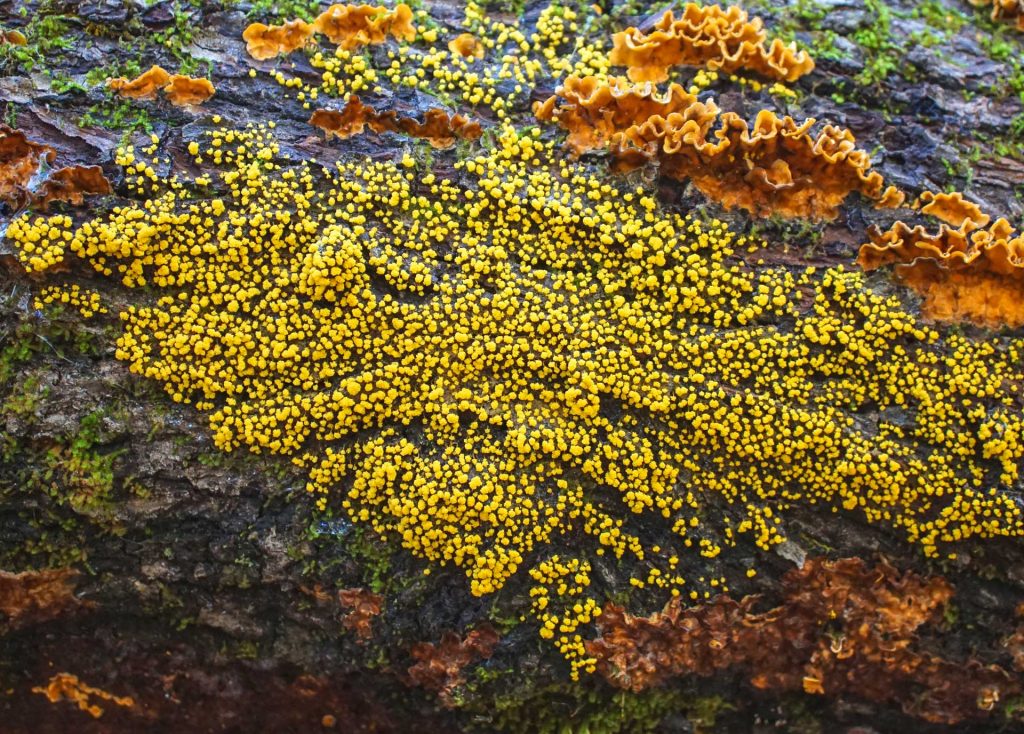
Physarum polycephalum, an acellular slime mold or myxomycete popularly known as “the blob” is a protist with diverse cellular forms and broad geographic distribution. The “acellular” moniker derives from the plasmodial stage of the life cycle: the plasmodium is a bright yellow macroscopic multinucleate coenocyte shaped in a network of interlaced tubes. This stage of the life cycle, along with its preference for damp shady habitats, likely contributed to the original mischaracterization of the organism as a fungus. P. polycephalum is used as a model organism for research into motility, cellular differentiation, chemotaxis, cellular compatibility, and the cell cycle.
Contents
Life cycle and characteristics
The two vegetative cell types, amoebae and plasmodia, differ markedly in morphology, physiology and behavior. Amoebae are microorganisms, typically haploid, that live primarily in the soil, where they phagocytose bacteria. In the laboratory amoebae are grown on lawns of live or dead Escherichia coli on nutrient agar plates, where they can multiply indefinitely. Axenic culture of amoebae was achieved through selection of mutants capable of axenic growth. Under conditions of starvation or desiccation, the amoebae differentiate reversibly into dormant spores with cell walls. When immersed in water, amoebae differentiate reversibly into flagellated cells, which involves a major reorganization of the cytoskeleton.
The plasmodium is typically diploid and propagates via growth and nuclear division without cytokinesis, resulting in the macroscopic multinucleate syncytium. While nutrients are available, the network-shaped plasmodium can grow to a foot or more in diameter. Like amoebae, the plasmodium can consume whole microbes, but also readily grows axenically in liquid cultures, nutrient agar plates and on nutrient-moistened surfaces. When nutrients are provided uniformly, the nuclei in the plasmodium divide synchronously, accounting for the interest in using P. polycephalum as a model organism to study the cell cycle, or more specifically the nuclear division cycle. When the plasmodium is starved, it has two alternative developmental pathways. In the dark, the plasmodium typically differentiates reversibly into a dormant “sclerotium” (the same term is used for dormant forms of fungal mycelia, but the myxomycete sclerotium is a very different structure). When exposed to light, the starving plasmodium differentiates irreversibly into sporangia that are distinguished from other Physarum species by their multiple heads (hence polycephalum). Meiosis occurs during spore development, resulting in haploid dormant spores. Upon exposure to moist nutrient conditions, the spores develop into amoebae, or, in aqueous suspension, into flagellates. The life cycle is completed when haploid amoebae of different mating types fuse to form a diploid zygote that then develops by growth and nuclear division in the absence of cytokinesis into the multinucleate plasmodium.
In laboratory strains carrying a mutation at the matA mating type locus, the differentiation of P. polycephalum plasmodia can occur without the fusion of amoebae, resulting in haploid plasmodia that are morphologically indistinguishable from the more typical diploid form This enables easier genetic analysis of plasmodial traits that would otherwise require backcrossing to achieve homozygosity for analysis of recessive mutations in diploids. Sporangia from haploid plasmodia generate spores with low fertility, and it is assumed that viable spores develop from meiosis of rare diploid nuclei in the otherwise haploid P. polycephalum plasmodia. Apogamic development can also occur in nature in various species of myxomycetes In the figure of the P. polycephalum life cycle, the typical haploid-diploid sexual cycle is depicted in the outer circuit and the apogamic cycle in the inner circuit. Note that an apogamic amoeba retains its matA1 mating type specificity and can still fuse sexually with an amoeba of a different mating type to form a diploid heterozygous plasmodium—another characteristic that facilitates genetic analysis. P. polycephalum amoebae growing on lawns of live E. coli. The bacterial cells are approx 1 micron in diameter, amoebae are approx 10 microns in diameter. Bright circular structures inside the amoebae are vacuoles, nuclei are pale grey circles each containing a darker nucleolus. (Phase contrast microscopy.)
As the life cycle diagram indicates, amoebae and plasmodia differ markedly in their developmental potential. A remarkable further difference is the mechanism of mitosis. Amoebae exhibit “open mitosis” during which the nuclear membrane breaks down, as is typical of animal cells, before reassembling after telophase. Plasmodia exhibit “closed mitosis” during which the nuclear membrane remains intact. This presumably prevents nuclear fusion from occurring during mitosis in the multinucleate syncytium. In support of this inference, mutant amoebae defective in cytokinesis develop into multinucleate cells, and nuclear fusions during mitosis are common in these mutants.
Cytoplasmic streaming
The plasmodium of myxomycetes, and especially that of Physarum polycephalum is known for its cytoplasmic streaming. The cytoplasm undergoes a shuttle flow rhythmically flowing back and forth, changing direction typically every 100 seconds. Flows can reach speeds of up to 1mm/s. Within the tubular network flows arise due to the cross-sectional contractions of the tubes that are generated by the contraction and relaxation of the membranous outer layer of the tubes enriched with acto-myosin cortex. In stationary plasmodia tubular contractions are spatially organized across the entire plasmodium in a peristaltic wave.
Cytoplasmic streaming is likely to contribute to plasmodium migration. Here, contraction patterns are observed to correlate with migration speed For dumbbell-shaped microplasmodia, often termed Amoeboid plasmodia, stiffening of the cortex in the rear versus the front seems instrumental in breaking the symmetry for the contraction wave to translate into migration.
Cytoplasmic flows enable long-ranged transport and dispersion of molecules within the cytoplasm. The physical mechanism employed here is Taylor dispersion. Under starvation the organism may reorganize its network morphology and thereby enhance its dispersion capabilities. In fact, the flows are even hijacked to transport signals throughout the plasmodium network. It is likely that the feedback of transported signals on tube size underlies Physarum’s capability to find the shortest path through a maze.
Situational behavior
Network created by P. polycephalum.P. polycephalum plasmodium cultivating two “islands” of agar substrate overlying a glass coverslip.
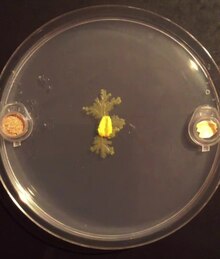
Physarum polycephalum growing from an oat flake (center) towards hairy roots of the plant Valeriana officinalis (left).
Physarum polycephalum has been shown to exhibit characteristics similar to those seen in single-celled creatures and eusocial insects. For example, a team of Japanese and Hungarian researchers have shown P. polycephalum can solve the shortest path problem. When grown in a maze with oatmeal at two spots, P. polycephalum retracts from everywhere in the maze, except the shortest route connecting the two food sources.
When presented with more than two food sources, P. polycephalum apparently solves a more complicated transportation problem. With more than two sources, the amoeba also produces efficient networks In a 2010 paper, oatflakes were dispersed to represent Tokyo and 36 surrounding towns P. polycephalum created a network similar to the existing train system, and “with comparable efficiency, fault tolerance, and cost”. Similar results have been shown based on road networks in the United Kingdom and the Iberian peninsula (i.e., Spain and Portugal). P. polycephalum not only can solve these computational problems but also exhibits some form of memory. By repeatedly making the test environment of a specimen of P. polycephalum cold and dry for 60 minute intervals, Hokkaido University biophysicists discovered that the slime mold appears to anticipate the pattern by reacting to the conditions when they did not repeat the conditions for the next interval. Upon repeating the conditions, it would react to expect the 60 minute intervals, as well as testing with 30 and 90 minute intervals.
P. polycephalum has also been shown to dynamically re-allocate to apparently maintain constant levels of different nutrients simultaneously. In one particular instance, a specimen placed at the center of a Petri dish spatially re-allocated over combinations of food sources that each had different protein–carbohydrate ratios. After 60 hours, the slime mold area over each food source was measured. For each specimen, the results were consistent with the hypothesis that the amoeba would balance total protein and carbohydrate intake to reach particular levels that were invariant to the actual ratios presented to the slime mold.
As the slime mold does not have any nervous system that could explain these intelligent behaviours, there has been considerable interdisciplinary interest in understanding the rules that govern its behaviour. Scientists are trying to model the slime mold using a number of simple, distributed rules. For example, P. polycephalum has been modeled as a set of differential equations inspired by electrical networks. This model can be shown to be able to compute shortest paths. A very similar model can be shown to solve the Steiner tree problem However, these models are externally consistent but not internally explanatory, and as is usual for modelling they simplify – in this case assuming conservation of energy. To build more realistic models, more data about the slime mold’s network construction needs to be gathered. To this end, researchers are analysing the network structure of lab-grown P. polycephalum
In a book and several preprints that have not been peer reviewed, it has been claimed that because plasmodia appear to react in a consistent way to stimuli, they are the “ideal substrate for future and emerging bio-computing devices“. An outline has been presented showing how it may be possible to precisely point, steer and cleave plasmodium using light and food sources, especially Valerian root. Moreover, it has been reported that plasmodia can be made to form logic gates, enabling the construction of biological computers. In particular, plasmodia placed at entrances to special geometrically shaped mazes would emerge at exits of the maze that were consistent with truth tables for certain primitive logic connectives. However, as these constructions are based on theoretical models of the slime mold, in practice these results do not scale to allow for actual computation. When the primitive logic gates are connected to form more complex functions, the plasmodium ceased to produce results consistent with the expected truth tables.
Even though complex computations using Physarum as a substrate are currently not possible, researchers have successfully used the organism’s reaction to its environment in a USB sensor and to control a robot.
Senses
Chemosensation
Food source chemosensation (taste)
The surfaces of P. polycephalum cells have glycoconjugate receptors for wheat germ agglutinins, Ricinus communis agglutinins, concanavalin A, and soybean agglutinins.
Innate immunity
P. polycephalum produces its own anti-viral substances. An extract of P. polycephalum prevents some crop diseases: Tobacco mosaic virus and tobacco ringspot virus are inhibited by a product of P. polycephalum. Both Nicotiana tabacum and the beans Phaseolus vulgaris and Vigna sinensis suffered almost no lesioning in vitro from TMV or TRSV when treated with a P. polycephalum extract. However, the southern bean mosaic virus was unaffected. https://en.wikipedia.org/wiki/Physarum_polycephalum
—–
Physarum polycephalum, plus couramment appelé blob, est une espèce unicellulaire de myxomycète de l’ordre des Physarales, vivant dans les milieux frais et humides tels que les tapis de feuilles mortes des forêts ou le bois mort. Cet amibozoaire est classé depuis 2015 parmi les mycétozoaires
Organisme capable de prendre diverses formes, Physarum polycephalum, bien que n’ayant pas de cerveau, est doté de certaines capacités d’apprentissage Comme les champignons, dont il ne fait pas partie, cet organisme monocellulaire possède des milliers de répliques de son noyau (permettant sa fragmentation et la fusion des fragments), ce qui a suscité une erreur historique : on a longtemps cru que cette cellule géante était un champignon et qu’elle possédait plusieurs noyaux, et Physarum polycephalum a donc longtemps été qualifié de « mycète » et de « polynucléaire »
Dénomination scientifique et surnom médiatique
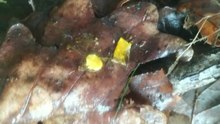
Croissance d’un plasmodium de Physarum polycephalum.
Son nom binominal Physarum polycephalum lui est donné en 1822 par le mycologue américain Lewis David von Schweinitz. Le nom générique Physarum, mélange de grec et de latin, signifie littéralement « petite vessie » ; l’épithète spécifique polycephalum signifiant « à plusieurs têtes ». Le nom de genre possède de nombreux synonymes, dont Didymium ou Lignydium.
Au xxie siècle, ce myxomycète a été surnommé « le blob » en référence aux autres utilisations du mot anglais blob (bien que les anglophones n’emploient pas ce terme pour désigner ce myxomycète), notamment du film de science-fiction The Blob d’Irvin S. Yeaworth Jr. Ce film, sorti en 1958, a pour personnage central un extraterrestre géant et gluant qui grossit en avalant les habitants (la cellule de Physarum polycephalum, elle, double de taille tous les jours)
Le terme blob est encore couramment utilisé par la presse et les médias francophones en général.
Caractéristiques
Plasmode de Physarum polycephalum.
Visible à l’œil nu, Physarum polycephalum est généralement de couleur jaune, se nourrissant de spores et de sporophores de champignons, de bactéries et autres microorganismes. Physarum polycephalum est l’un des microorganismes eucaryotes les plus faciles à cultiver in vitro (du papier absorbant humide et des flocons d’avoine suffisent) et est utilisé comme organisme modèle pour de nombreuses études sur les mouvements amiboïdes et la motilité cellulaire.
Répartition
On le trouve sur tous les continents, dans des milieux humides, doux et ombragés, en forêt, dans des arbres ou dans la litière en décomposition, mais aussi dans le désert ou sous la neige.
Cycle de vie
Cycle de vie de Physarum polycephalum.Phase reproductrice, constitution des sporocystes.Sporocystes.Sporocystes bruns en phase de sporulation.
La principale phase végétative de Physarum polycephalum est le plasmode ou plasmodium. Ce plasmode est constitué de réseaux de veines protoplasmiques qui assurent la distribution des nutriments, et de nombreux noyaux. C’est au cours de cette étape que l’organisme cherche de la nourriture. Le plasmodium entoure sa nourriture et sécrète des enzymes pour la digérer.Sclérote en formation.
Si les conditions environnementales entraînent la dessiccation du plasmode lors de l’alimentation ou de migration, il se forme alors un sclérote. Le sclérote est multinucléé et constitué de tissus très renforcés servant de stade de dormance, assurant ainsi la protection de Physarum polycephalum pendant de longues périodes. Une fois les conditions favorables revenues, le plasmode réapparaît pour poursuivre sa quête de nourriture.
Quand les réserves alimentaires sont épuisées, le plasmode entre en phase de reproduction pour former des sporocystes. Des sporocystes se forment dans le plasmode, la méiose se produit au sein de ces structures et les spores se forment. Les sporocystes se forment habituellement à l’air libre pour que les spores soient dispersées par le vent. Les spores peuvent rester viables pendant des années. Toutefois, lorsque les conditions environnementales sont favorables à la croissance, les spores germent et libèrent des cellules soit flagellées, soit amiboïdes (stade mobiles). Les cellules fusionnent ensuite pour former un nouveau plasmode.
La fusion n’a lieu que si les Physarum polycephalum sont de types sexuels différents, ce qui a de grandes chances de se produire puisqu’il en existe 720 différents. Le type sexuel du blob est en effet déterminé par trois sites génétiques, notés matA, matB et matC, qui disposent respectivement de 16, 15 et 3 allèles connus (pour un total de 720 combinaisons différentes)
Génétique
Le génome de Physarum polycephalum est partiellement séquencé
Physarum polycephalum est souvent utilisé pour les études sur l’édition biologique ; c’est à ce jour le seul organisme connu pour éditer l’acide ribonucléique (ARN) à la fois par insertion et substitution de nucléotides.
Comportement
Déplacement
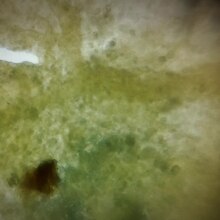
Déplacement intracellulaire dans un plasmode de P. polycephalum.
Le déplacement du Physarum polycephalum est lié à un courant cytoplasmique appelé « shuttle streaming » en anglais, évoquant le va-et-vient d’une navette (shuttle). Ce shuttle streaming est caractérisé par un changement de direction d’avant en arrière du flux de cytoplasme, avec un intervalle de temps d’environ deux minutes. À l’intérieur des plasmodes, la force motrice est générée par la contraction suivie de la relaxation de couches membraneuses probablement constituées d’actine (de type filament d’actine associé à la contraction). La couche de filaments crée un gradient de pression grâce auquel le cytoplasme s’écoule à l’intérieur du plasmode.
Le blob secrète un mucus qui le protège contre la dessiccation mais a aussi un rôle répulsif qui lui évite d’explorer deux fois la même piste. Cette mémoire spatiale externalisée lui permet de se déplacer à 1 cm/h
Apprentissage
Culture en boite de Pétri sur une couche de flocons d’avoine.Expérience de l’habituation avec P. polycephalum.
Physarum polycephalum peut présenter des comportements très étonnants que la recherche scientifique n’a pas encore totalement expliqués. Une équipe de recherche du CNRS a montré que Physarum polycephalum peut non seulement apprendre mais également transmettre les nouvelles informations mémorisées à des congénères en fusionnant temporairement avec eux
Dans l’expérience de cette équipe, 4 000 individus sont séparés en deux groupes de taille identique, le groupe H (« habitué ») et le groupe N (« naïf »). Les individus du groupe H s’entraînent à réprimer leur répulsion naturelle pour des substances inoffensives comme le sel pour aller chercher leur nourriture de l’autre côté d’un pont qui en est recouvert ; ceux du groupe N doivent seulement traverser un pont dépourvu de ces substances. Ensuite, on met des individus de chaque groupe dans la même situation, consistant à devoir traverser un pont recouvert de sel pour aller chercher leur nourriture : on constate que les individus du groupe H sont bien plus rapides à la tâche.
Dans un deuxième temps, on crée des couples HH, HN et NN, et on les met à nouveau ensemble dans cette situation. On constate alors que, pour aller chercher leur nourriture, les individus N qui s’associent à des individus H sont aussi rapides qu’eux ; ils sont beaucoup plus rapides que les autres individus N. Enfin, on recommence en séparant les couples soit une heure soit trois heures après les avoir laissés dans un état où ils sont fusionnés, puis on les soumet à nouveau à l’épreuve du pont de sel. On constate alors que, parmi les N qui étaient fusionnés avec un H, seuls ceux qui l’avaient été pendant trois heures sont aussi rapides que des H.
Les chercheurs remarquent que c’est aussi le temps requis pour qu’une sorte de veine se forme entre les deux individus fusionnés. Ils émettent alors l’hypothèse encore non vérifiée (décembre 2016) selon laquelle cette veine serait le moyen par lequel les informations sont transmises d’un Physarum polycephalum à l’autre. On ignore pour l’instant sous quelle forme cette information est transmise et traitée
Cette notion d’apprentissage doit être considérée avec précaution, elle incite à un biais interprétatif qui laisse supposer une certaine forme d’intelligence via la mémorisation d’informations. Le communiqué de presse initial ne cite qu’une capacité « d’habituation » face aux contraintes de l’expérience. Plusieurs solutions de réactions biologiques peuvent avoir lieu dans le groupe H et y être enregistrées sans faire appel à une quelconque forme d’intelligence, entre autres des modifications épigénétiques peuvent être envisagées, voire plus, compte tenu de la plasticité génétique de Physarum polycephalum
Résolution de labyrinthes
Physarum polycephalum dans un labyrinthe.Optimisation d’un réseau par P. polycephalum.
Une équipe de chercheurs japonais et hongrois considère que Physarum polycephalum est capable de se déplacer dans un labyrinthe d’agar-agar en identifiant le plus court chemin possible quand deux morceaux de nourriture sont placés à chaque entré. En réalité, Physarum polycephalum parcourt tout le labyrinthe et persiste uniquement sur le chemin le plus court.
Une étude démontre que Physarum polycephalum peut résoudre des problèmes complexes mettant en jeu plus de sources de nourriture. Pour ce faire, les chercheurs déposent l’organisme sur une surface où sont dispersés des points de nourriture représentant les différentes villes de la région de Tokyo. Physarum polycephalum crée un réseau optimisé entre les sources de nourriture, en reliant de la manière la plus efficace les différentes stations
Anticipation des stimuli
En générant de façon répétée des stimuli de chaud et de froid à Physarum polycephalum, et ce avec 60 minutes d’intervalle, des biophysiciens de l’université de Hokkaidō découvrent que le plasmode peut anticiper ces stimuli en y réagissant même quand ceux-ci sont absents. Ils montrent également que ces résultats peuvent être obtenus en appliquant les stimuli avec un intervalle de 30 ou 90 minutes
Calcul
Andrew Adamatzky de l’université de Bristol montre comment il est possible d’orienter ou de cliver un plasmode en utilisant la lumière ou des sources de nourriture. Dans la mesure où des plasmodes réagissent toujours de la même manière aux mêmes stimuli, Adamatzky suggère que Physarum polycephalum constitue « un modèle idéal pour de futurs outils de bioinformatique »
Nutrition
Une équipe de l’université Toulouse-III-Paul-Sabatier montre que Physarum polycephalum est capable de choisir le régime le plus adapté à son métabolisme lorsqu’il est mis en présence de nombreuses sources de carbone et d’azote différentes
Robotique
Les particularités comportementales de Physarum polycephalum sont mises à profit lors de la fabrication d’un robot hexapode qui fuit la lumière pour se cacher dans des zones d’ombre. Des chercheurs de l’université de Southampton font pousser l’organisme sur une surface en étoile à six branches au-dessus d’un circuit qui le connecte au robot via un ordinateur. Lorsque Physarum polycephalum est exposé à la lumière et qu’il tente de se rétracter, son mouvement est enregistré par le circuit et transmis aux pattes du robot, qui s’éloigne de la source lumineuse, reproduisant ainsi de façon mécanique les réponses biologiques du microorganisme
Vulgarisation et pédagogie
En octobre 2019, un blob fait son entrée au parc zoologique de Paris. Il n’est pas confié aux soigneurs, mais aux jardiniers21.
En 2021 le CNES et le CNRS, à l’occasion de la mission Alpha dans la Station spatiale internationale prévue le 23 avril, mettent en place une expérience pédagogique sur le blob dénommée « Élève ton blob ». Des écoles primaires, collèges et lycées à qui seront confiés des blobs pourront comparer leur évolution à celle de quatre blobs emmenés à bord de la station par Thomas Pesquet. L’expérience développée par le CNES en collaboration avec la scientifique Audrey Dussutour et d’autres acteurs, est supervisée par le centre de support des opérations BIOTESC (Biotechnology Space Support Center) en Suisse et est réalisée pendant l’année 2021.
Projet de recherche participatif
En 2021, Le CNRS a lancé un projet de science participative consistant à étudier de manière précise les impacts des changements de température sur le blob. Toute personne âgée de plus de huit ans peut participer à ce projet. Les personnes participantes recevront un blob et devront s’en occuper et simuler des vagues de chaleurs afin de recueillir des données qui seront par la suite étudiées par une équipe de recherche.https://fr.wikipedia.org/wiki/Physarum_polycephalum
—–
Der Blob – Schleimiger Superorganismus
INFO • DO., 21.10. • 51 MIN.Science-Fiction für Realisten: „The Blob“ erobert die Leinwand – und die Labore! In einem B-Movie von 1958 taucht die Bezeichnung zum ersten Mal auf. Der Blob, eine außerirdische Schleimmasse, bedroht die Erde mitsamt ihren Bewohnern. Diese Horrorfilm-Kreatur dient als Vorlage für den Spitznamen eines sehr realen Organismus, der auch wie nicht von dieser Welt zu sein scheint: Physarum polycephalum. Dieser Blob ist weder Tier noch Pflanze – und ein Alien erst recht nicht. Denn er lebt seit fast einer Milliarde Jahre auf diesem Planeten. Das macht ihn zu einer der ältesten Lebensformen – und zu einer der einfachsten: Der Blob besteht nämlich aus nur einer einzigen Zelle. Doch hinter seiner einfachen Fassade verbergen sich unglaubliche Fähigkeiten. Der Einzeller hat weder Augen noch Mund noch Magen noch Füße – und doch sieht, verdaut und geht er. Auch ohne Gehirn ist er in der Lage, komplexe Probleme zu lösen, den kürzesten Weg in einem Labyrinth zu finden und Informationen zu speichern und weiterzugeben. Der Blob ist zwar ein einzelliger Organismus; er besitzt aber viele identische Zellkerne, die zusammen eine Riesenzelle bilden. Das macht den Einzeller mit bloßem Auge sichtbar – und damit zu einem beliebten Forschungsobjekt für Wissenschaftler auf der ganzen Welt. Sie präsentieren die unglaublichen Fähigkeiten des Blobs und stellen ein wissenschaftliches Arbeitsfeld vor, in dem Intelligenz nichts mit Gehirnen zu tun hat. Jacques Mitsch hat mit seinem Film ein bemerkenswertes Porträt über ein außergewöhnliches Wesen geschaffen. Unterstützt wurde er dabei von Audrey Dussutour, einer Wissenschaftlerin, die erst vor kurzem die erstaunlichen Fähigkeiten dieses Evolutionswunders aufdeckte.
https://www.prisma.de/mediathek/arte/dokumentation/der-blob/schleimiger-superorganismus,31417754
https://www.arte.tv/de/videos/082726-000-A/der-blob/
MYSTERIUM DER NATUR: Dieser „Blob“ im Pariser Zoo hat 720 Geschlechter
Think Single-Celled Organisms Are Simple? Think Again! The Slime Mold Physarum polycephalum, a Single-Celled Organism for Student Investigations
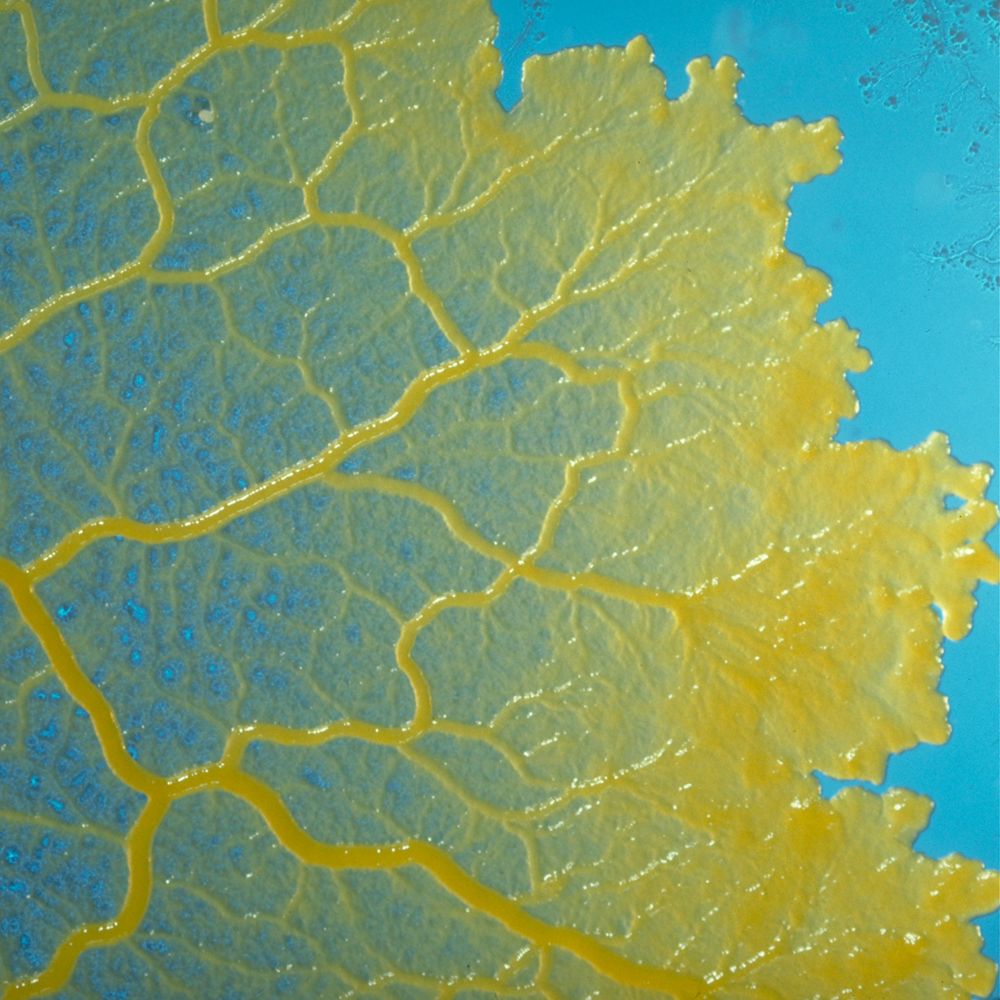
Elizabeth Paine, PhD
Product Developer
The slime mold Physarum polycephalum is a single-celled organism that can convert to multiple forms and that displays surprising complexity in its behavior. In one of its forms, the single cell can become very large—more than 30 cm in diameter in a laboratory setting. In nature, Physarum polycephalum is found in multiple environments; however, the organism is most commonly found in cool, humid, dark places such as leaf litter and other organic debris in forests. It can be used to discuss multiple subjects, including life cycles, mitosis, meiosis, sexual and asexual reproduction, cytoplasmic streaming, chemotaxis, basic navigation, simple decision-making, mechanisms for survival in stressful environments, cell structure, and developmental biology.
Potential investigations
With a little care and attention, Physarum polycephalum is easy to grow in the classroom and is a good organism for students to use for independent investigation. Below are some ideas for student investigations, followed by background information on the organism.
- Have students construct a maze. In the plasmodial phase, the organism can become very large and forages a great deal. Have students construct a maze and test a Physarum plasmodium’s ability to find its way through it, or to connect a source of food at the beginning of the maze with a source of food at the end of the maze using the shortest path. Be aware that the plasmodium, depending upon the materials composing the maze and the ambient conditions, will sometimes cross the maze walls. Students may want to experiment with using different types of material to make the maze or using different things to coat the maze in order to avoid this.
- Investigate chemotaxis. Have students test the ability of different substances to attract or repel a Physarum plasmodium. Have students perform their test in multiples and use statistics to measure the significance of their observations.
- Have students explore the effects of temperature on the plasmodial form of Physarum.
- Have students examine the effect of the slime track that a Physarum plasmodium leaves behind when it exits an area on a plasmodium’s willingness to forage in that area.
- Under conditions of stress, Physarum polycephalum takes on a form referred to as a sclerotium. Have students explore what conditions cause a sclerotium to form. They could test the effect of desiccation, solutions of different metals, cold and hot temperatures, changes in pH, starvation in the dark, etc.
Background on Physarum polycephalum
Many of the processes used by Physarum are similar to those found in more complex organisms. Thus, Physarum has been used as a model for studying many of the basic processes present in many organisms, including cell differentiation, cell cycle regulation, mitosis, meiosis, cytoskeletal rearrangement, and cytoplasmic streaming.
In addition, the ability of Physarum to navigate using relatively complex strategies to find food and to form networks between different sources of food has drawn the attention of people outside traditional areas of biological research, including those who study networks and artificial intelligence.
Life cycle
During its life cycle, Physarum polycephalum transitions into different forms, some of them haploid, others diploid, and some designed to protect the organism under harsh conditions. The organism’s transition from one form to another is most often triggered by the conditions of its environment, including the presence or absence of other Physarum.

Physarum polycephalum in plasmodial form
Plasmodial form
In the classroom, Physarum is most often observed in its diploid, plasmodial form. In its plasmodial form Physarum polycephalum exists as a single large cell containing multiple diploid nuclei that replicate their DNA and divide synchronously. These single cells are capable of becoming very large.
Sporulation
When a plasmodium is starved and then exposed to light, it will sporulate. In nature, the organism has been observed to sporulate after climbing out of leaf litter to where it gets exposed to light. These small, dark spores can survive for many years. Thus, the formation of spores is one way the organism ensures that it will survive harsh conditions until more favorable living conditions return. Sporulation is also the first step in sexual reproduction.
During early sporulation the organism forms fruiting bodies, which initially appear as bumps emerging from the surface of the plasmodium. These bumps develop into stalk-shaped structures that project from the plasmodium surface. When viewed under the microscope they are quite dramatic. A fully developed spore contains only a single haploid nucleus.
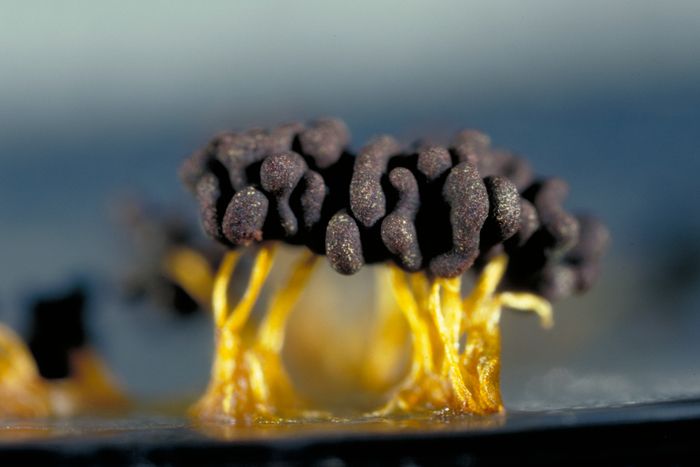
Physarum polycephalum sporulating
Amoebas and flagellates
When there is sufficient moisture, haploid, single nucleus amoebas emerge from the spores. In contrast to what occurs in the plasmodial form, mitosis in the amoeboid form is accompanied by cell division. Repeated division of the Physarum amoeba results in a colony of amoebas that are genetically the same.
The amoeba can change into 2 different forms, flagellates (cells with 2 flagella) or cysts. The transformations from amoeba to flagellate and from amoeba to cyst are both reversible. If an amoeba runs out of food or encounters other adverse conditions—for example, dryness—it forms a cyst with protective walls. When the conditions become more favorable again, an amoeboid cell reemerges from the cyst. Transformation to a flagellate occurs under wet conditions. Flagellates will transform back into amoebas under drier conditions. The amoeba’s ability to make these transformations allows the organism to survive a broader range of conditions than it would otherwise.
Sexual reproduction
Genetic diversity is beneficial to the long-term survival of a species. As is true for most organisms, sexual reproduction is one of the mechanisms generating genetic diversity in Physarum polycephalum. The combining of genetic material from 2 different organisms occurs when 2 haploid amoebas fuse with each other to form a single organism with a single diploid nucleus. This single diploid cell then goes on to develop into a plasmodium. The mating of the 2 amoebas is controlled by several multi-allele mating loci.
Sclerotium
As discussed above, Physarum polycephalum when in the amoeboid form can respond to stressful conditions by forming a cyst. When in the plasmodial form, Physarum responds to starvation and light by sporulating. However, if the stressful conditions occur in the absence of light, the plasmodium will form a sclerotium, a collection of macrocysts (also called spherules) surrounded by a hard, dry protective layer. Sclerotia can form in response to a number of stimuli, including starvation, dryness, cold, low pH, and solutions with high osmotic pressure and exposure to some heavy metals. Depending upon the conditions, a sclerotium can be revived to the active form of the organism for months after it forms.
Foraging and streaming
Physarum in the plasmodial form uses phagocytosis to ingest its food, which consists of small particles of organic material, bacteria, and other microorganisms. It also secretes enzymes to break down materials, which are then absorbed by pinocytosis. As it forages, the plasmodial form of Physarum moves around using a slow flowing movement. The part of the organism that is at the forefront of foraging has a fanlike configuration. As the organism searches for and takes in food, the cell contents stream back and forth at approximately 60-second intervals through a network of vein-like looking tubes. A single vein can be up to 1 mm in diameter, and streaming can be easily observed using a stereomicroscope. Absorbed material gets distributed throughout the cell using this mechanism. The network of tubes is reorganized as the organism moves in search of food.
The periodic streaming is accomplished through the creation of hydraulic pressure gradients. Contraction of the actomyosin network within the plasmodium creates these pressure gradients. The actomyosin network is part of an extensive network of microfilaments that exists throughout the entire plasmodium. Multiple other proteins are associated with this network. As a group, these proteins are referred to as actin-binding proteins and play a role in carrying out the functions of the actomyosin network, including its reorganization.
Foraging strategies
The strategies used by the plasmodial form of Physarum to find food are surprisingly complex. At a basic level, the organism senses food at a distance, detects when it moves closer to or farther away from the food, and adjusts its movement according to the input it receives. This is a simple example of chemotaxis. However, the organism has at least one additional strategy for optimizing how it searches an environment for food. When seeking food, the plasmodium avoids any areas it has explored until it has covered all unexplored areas. This behavior is thought to increase the efficiency of its foraging. This type of foraging strategy has long been observed and studied in more complex organisms with internal neurologic memory that can be used to remember where the organism has been. However, Physarum polycephalum is a unicellular organism without a neural network for remembering. In the absence of a neurological memory, the organism creates a type of external memory by leaving a slime trail in areas from which it withdraws. The organism then strongly avoids areas with a slime track until it has explored all areas without residual slime or unless a new food source is placed in the slime-covered area.
In addition, as part of its foraging behavior Physarum can form networks connecting multiple food sources. These networks are similar to those created by humans with respect to efficiency. For example, a research group interested in the cost, efficiency, and resilience of networks hypothesized that a biological organism such as Physarum polycephalum, which has had its network forming strategies honed by years of natural selection, may provide good inspiration for the creation of networks that optimally balance these 3 characteristics. The research group created a model of the Tokyo area for Physarum polycephalum by placing food sources at the places representing the locations of major cities along the Tokyo rail network. Geographical features that had constrained the building of rail lines were represented as illuminated areas that would similarly be avoided by network-forming Physarum. The network built by the Physarum placed in this representative model was very similar to the existing rail line network.
In addition, the organism can make relatively complex decisions regarding its diet. Plasmodia with access to patches of food, which varied with respect to the carbohydrate-to-protein ratio and in the concentrations of each, migrated to the patch that provided the optimal diet.
The genome
Sequencing the 250 megabase genome of Physarum polycephalum has been difficult because it has many regions where a short, specific sequence of nucleotides repeats many times in a row and areas where a single type of nucleotide is repeated many times. These characteristics make sequencing challenging and make assembling a complete genome from the sequences obtained difficult. To supplement the data obtained from sequencing the genome, researchers created a transcriptome. A transcriptome is a collection of the sequences of the RNAs transcribed by a certain cell type. In this case the “cell type” is actually the complete organism. The researchers pooled transcriptome sequence data from multiple life cycle stages. Computer analysis of the data predicted the presence of 34,438 genes. Half of these predicted gene loci could be linked to a transcript. Analysis of this data and comparison to similar data from closely related and even not so closely related organisms has provided information regarding the evolutionary relationships between the different organisms. For example, 2 phytochrome genes found in the Physarum genome appear to code for proteins that are most similar to bacterial phytochrome proteins. They also show some similarity to plant phytochromes. Interestingly, other apparent photoreceptor genes in the Physarum genome show the greatest similarity to gene sequences in animals. More studies will need to be done to elucidate the connections suggested by this data. These types of studies may one day make it clear how Physarum polycephalum came to possess characteristics displayed in organisms that occupy very different categories.
Related products
- Living Physarum Review Set (item #155774)
- Physarum Culture Kit (item #155825)
- Physarum polycephalum Plasmodium, Living Culture, Plate (item #156193)
- Physarum polycephalum Sclerotium, Living Culture, Box (item #156190)
